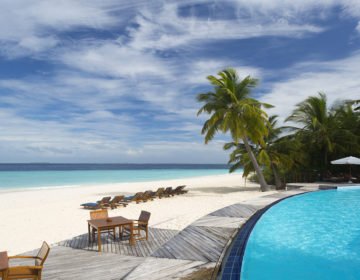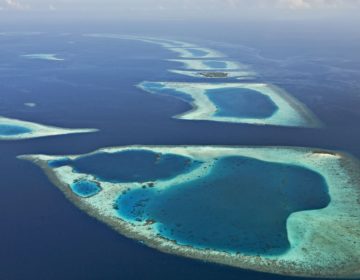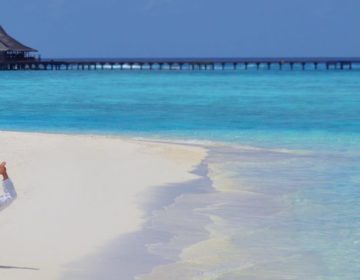Baros Thila
To the south of Baros is a thila with the top at eight meters. On the north side are a couple of caves and overhangs at 27 meters. On the west side is sand at 23 meters then another ridge of reef continues at 22 meters. Baros thila is well known for its grey reef and white-tip reef sharks. Also feeding here are barracuda and big dog-toothed tuna. During the north-east monsoon sharks and pelagics are mostly found on the eastern side while during the south-west monsoon they are usually on the western side. The best time for diving here is usually February, March and April.
 Baros thila is well known for its grey reef and white-tip reef sharks (seen above).
Baros thila is well known for its grey reef and white-tip reef sharks (seen above).
The Wall
At Ilhuru there is excellent snorkeling and diving on the house reef. The wall is a popular shore dive where about half a dozen stingrays are regularly fed and as a result are quite tame.
Shallow Point
To the south of Nakatchachaafushi is a small Thila with the reef top at eight meters. The reef slopes gently to around 20 meters. Coral growth is lacking, but there is plenty of blue-striped snapper, surgeonfish and batfish. One of the main features of this reef is hundreds of sea anemones with black-footed anemonefish. This fish is only found in the Maldives, and they thrive on this reef. The small saddled pufferfish is common and on the sand and coral rubble are many lizardfish.
 On the sand and coral rubble are many lizardfish.
On the sand and coral rubble are many lizardfish.
Nakatcha Thila
This thila lies inside Rasfari Kandu. It is a medium-sized thila with a maximum depth of 26 meters. It has big, bright caves and magnificent overhangs starting at 10 meters.
Mas Thila
In Dhivehi, Mas means fish and the lack of coral on this reef is made up for by the quantity of fish life. It has a maximum depth of 30 meters and is about 150 meters long. Vast schools of plankton eaters like schooling bannerfish and fusilier congregate on the northern end of the thila. Sometimes cruising along reef edge are schools of barracuda, rainbow runner and some big tuna, often alone and other times in twos and threes. On the reef slopes are green coral trees and stingrays.
 Vast schools of plankton eaters like schooling bannerfish congregate on the northern end of the thila.
Vast schools of plankton eaters like schooling bannerfish congregate on the northern end of the thila.
Banana Reef
On the south side of Rasfari Kandu, a wide reef plateau sloping to 10 meters extends into the channel. On the outside corner are inlets dropping to a sandy bottom at 25 meters. On the sandy bottom are garden eels and goatfish, while on the reef slope are big schools of blue triggerfish. They can be seen everywhere on the reef with their tails sticking out from small holes. There are also large schools of smaller fish like flame basslet, black pyramid butterfly fish and surgeon. Lionfish are fairly common. One ridge extends seawards near the corner and has a sharp drop off form about 30 meters with many sea fans. The channel is shallow and sandy at 17 meters. On the upper reef are morays, lobsters, snapper, and fusilier. Manta rays are seen here during the north-east monsoon.
 On the sandy bottom are garden eels.
On the sandy bottom are garden eels.
Rasfari – PROTECTED MARINE AREA
There is plenty of variation of topography with sandy inlets and ridges cutting across an extensive outside reef. Resting on the sandy slopes are white-tip and black-tip reef sharks. The visibility is usually excellent, and an offshore reef, circular with the top at a depth of 28 meters can be seen from the main reef. This reef is more like a thila, and on the inside, the depth is 30 meters, while on the outside it drops off to well over 40 meters. The top of the thila provides an excellent viewing location for deep water pelagics.
Close encounters with grey reef sharks, schools of big-eye trevally, great barracuda and schools of eagle ray very often take place here. Oceanic whitetip sharks have been reported here. Also, of interest to fish watchers is the ocean triggerfish that comes in around the full moon for nesting on the deeper sandy slopes. On the main reef is an interesting terrain of coral ridges and patches of sand where there are large schools of green-face parrotfish, and many different types of reef fish.
 The ocean triggerfish that comes in around the full moon for nesting on the deeper sandy slopes.
The ocean triggerfish that comes in around the full moon for nesting on the deeper sandy slopes.
Diving Hints
The thila is some distance from the reef edge and divers should allow sufficient air to return to the reef to carry on the drift dive. Beware of running low on air for the return if diving deeper on the outside of the thila. Currents can increase rapidly in strength on the corner of Rasfari Kandu and divers should be careful of outgoing currents pushing them away from the reef. Safety balloons should always be carried here.
The parrotfish family are called Landaa in Dhivehi. The soft, white, tasty flesh is a favorite among Maldivians. Sultan Mohamed Shamsudeen III (1904 – 1934) was famous for this fish diet. Every day the head man from Hulhule, then inhabited, had to bring 2-3 fish to Malé for the Sultan.
 The parrotfish family are called Landaa in Dhivehi.
The parrotfish family are called Landaa in Dhivehi.
Bodu Hithi Thila
This is a long drift dive with the best diving on the southern end. The reef top is at eight to 10 meters, and there are three bays in the reef with sandy bottoms between 15 and 25 meters. On one point is a cave at 17 meters that divers can see through. There are sometimes four to six nurse sharks inside. Hard coral cover is poor, but there is plenty of healthy light blue and soft yellow coral. Along the reef slopes are big schools of fusilier, some tuna, grouper and sweetlips. On the sandy bottom are white-tip reef sharks. Manta rays are seen here between December and April and turtles frequent the reef top all year round. If currents are quite strong, then this thila is favored above others because of its size.
 Nurse shark
Nurse shark
Hembadhoo Wreck
The wreck is former tugboat sunk by a dive school in 1988. A buoy marks it, and the wreck is an easy shore dive. The wreck is 16 meters long with the top at 15 meters and the bottom at 22 meters. The boat is a focal point for marine life and is a fish-watchers delight. In the waters surrounding the wreck are blue-fin jack, black snapper, and midnight snapper. Around the rocks and in the wreck are schools of tiger cardinalfish, sabre squirrelfish, and tame snout-spot grouper. Bushy black coral trees are already well-established on this wreck.
Divers return to shore along the reef edge to the jetty. It is worth spending some time at the pier as it has its unique variety of marine life. Often seen here is a cow-tailed stingray with its distinctive long tail, and schools of snub-nose pompano, from the trevally family. There are a lot of juvenile wrasse as well as surgeon and schools of rabbitfish, that are mainly herbivores feeding on algae growth under the jetty.
 Around the rocks and in the wreck are schools of tiger cardinalfish.
Around the rocks and in the wreck are schools of tiger cardinalfish.
The Peak
The Peak is another big thila inside Hithi Kandu, and the best diving here is on the southern side. The top of the reef is at eight to ten meters and is about 300 meters long. On the reef slopes are plenty of small caves and one larger one that divers can swim through lies at the south-east end. Around the cave entrances are tailfin batfish and lionfish, while grazing on the slopes are numerous species of parrotfish. Other reef fish include bannerfish, snapper, Napoleon, and fusilier. Eagle rays are often seen swimming through the channel. The reef bottoms out onto the sand beds at 30 meters or less where stingrays are found at regular intervals. Hard coral cover is poor but in the caves are sea whips and sturdy sea fans. Mantas are seen between December and April.
Experience these once-in-a-lifetime dives and book your hotel here.
 Eagle rays are often seen swimming through the channel.
Eagle rays are often seen swimming through the channel.
(Source: Dive Maldives: A Guide to the Maldives Archipelago. Tim Godfrey. Atoll Editions, 2015)



